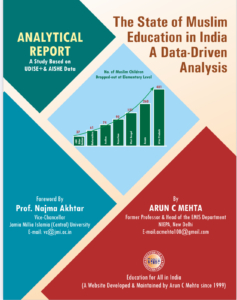A Critical Examination of Rajasthan’s School Infrastructure Survey (2025)
Discrepancies, Data Integrity, and Pathways to Reform
Introduction
The preliminary survey by the Rajasthan government, which identified nearly 87,000 classrooms in government schools as completely dilapidated, has spotlighted a dire crisis in educational infrastructure. Initiated following the devastating roof collapse at a government school in Jhalawar district on July 25, 2025, which resulted in the deaths of seven students and injuries to eight others, the survey’s findings have prompted swift judicial intervention. On August 23, 2025, the Rajasthan High Court banned the use of these 86,934 dilapidated classrooms and rooms, mandating alternative arrangements to ensure uninterrupted education for affected students. This order underscores the urgency of the issue, especially in light of a subsequent incident in Jaisalmer, where a school gate collapse on July 29, 2025, claimed one student’s life and injured two more.
Preventing School Ceiling Collapses: Lessons from the Jhalawar Tragedy
Compounding these concerns is the glaring inconsistency with data from the Unified District Information System for Education Plus (UDISE+), the Government of India’s official platform for school statistics. Numerous schools now deemed unsafe had previously reported no major issues in UDISE+, casting doubt on the system’s reliability and raising alarms about underreporting. This article critically dissects the survey, referencing UDISE+ data and recent media coverage, while scrutinizing allocations under the Samagra Shiksha scheme for repairs. It advocates for robust reforms, emphasizing accountability and community involvement to prevent future mishaps and enhance data quality, all while pursuing a truth-seeking perspective on this public safety imperative.
Review of Literature
Scholarly and media analyses of India’s school infrastructure consistently reveal entrenched challenges, including data inaccuracies that hinder effective policy implementation. Prof. Arun C. Mehta’s in-depth examinations of UDISE+ data, such as his 2023-24 analysis, critique the system’s vulnerabilities, noting enrollment adjustments that mask underlying infrastructure deficits. Mehta’s work underscores how NEP 2020’s goals for universal education by 2030 are jeopardized by unreliable reporting, a point echoed in the Rajasthan context where survey results contradict prior UDISE+ submissions.
Recent media outlets, including The Indian Express and Hindustan Times, have detailed the survey’s revelations and the High Court’s August 2025 ban, highlighting 5,667 entirely unsafe schools. Reports from The Wire and India Today further expose UDISE+ discrepancies, such as the Jhalawar school’s pre-collapse report of only minor repairs needed. Broader studies on Samagra Shiksha, including Mehta’s decoding of enrollment ratios, criticize fund mismanagement, with spill-overs indicating delayed repairs. Mehta’s proposals for AI-enhanced data management offer forward-looking solutions, while emphasizing the need for independent oversight to combat inflated or erroneous reporting. Collectively, the literature depicts a fractured system where reactive measures prevail over preventive strategies, demanding empowered community mechanisms for sustainable change.
Critical Review of the Survey
The Rajasthan survey, encompassing 63,018 government schools, exposes profound infrastructural decay: 86,934 classrooms completely dilapidated, alongside 158,467 tiled-roof rooms and 51,026 RCC-roof rooms needing major repairs. Toilets are similarly afflicted, with 17,109 fully dilapidated and 29,093 repairable. Representing 16% of the state’s 5.14 lakh classrooms, these figures – validated by the High Court’s recent prohibition on their use – demand scrutiny, particularly given officials’ attribution of high numbers to teachers’ “panic” reporting post-Jhalawar.
This rationale is inherently flawed, suggesting a culture of fear that discourages accurate disclosure until crises erupt. More alarmingly, the survey clashes with UDISE+ data, where affected schools often claimed minimal problems. For instance, the Jhalawar school’s UDISE+ 2023-24 entry noted only minor repairs for two classrooms, a severe underestimation that contributed to the tragedy. Such mismatches erode trust in UDISE+, now centrally administered, implying systemic incentives for downplaying risks to meet performance metrics.
Media updates as of August 2025 reinforce these critiques, with the High Court’s order highlighting the survey’s role in averting further harm. Nationally, UDISE+ 2023-24 reports tout advancements like 57.2% of schools having functional computers, yet omit detailed dilapidation metrics, enabling states to evade accountability. In Rajasthan, this oversight is stark: despite annual UDISE+ filings, action lagged until fatalities occurred, leading to teacher suspensions and judicial mandates.
Funding via Samagra Shiksha, designed to remedy such gaps, has been criticized for inefficiency. Critically, while approx Rs. 3,900 crore was disbursed in 2024-25, persistent spill-overs signal bureaucratic delays, undermining urgent needs. The scheme’s 2025-26 extension offers promise, but without stringent audits, allocations risk misdirection, perpetuating the cycle of neglect evident in the survey.
How to Prevent Such Incidents
Preventing recurrences like those in Jhalawar and Jaisalmer requires proactive, multifaceted interventions:
- Empowered Independent Committees: Form teams comprising parents, activists, prominent citizens, civil engineers, local leaders and others to assess school buildings’ status in Rajasthan. These groups should conduct on-site inspections, report findings transparently, and recommend actions. Based on this pilot’s outcomes, replicate such committees nationwide, institutionalizing them as regular annual activities across states to foster ongoing vigilance.
- Technical Audits and GIS Integration: Require yearly structural evaluations by engineers, linked to GIS apps for real-time mapping, as initiated in Rajasthan.
- Community Engagement: Involve parent-teacher bodies in monitoring, with app-based reporting to democratize oversight.
- Rapid Funding and Alternatives: Establish emergency funds under Samagra Shiksha for swift repairs, and enforce High Court-style relocations to safe sites during fixes.
- Accountability Measures: Launch thorough investigations into incidents, holding officials accountable beyond mere suspensions.
These steps, if empowered with decision-making authority, could shift from crisis response to sustained safety.
Improving Quality of UDISE+ Data and School Infrastructure
UDISE+’s data quality must be fortified to prevent life-threatening inaccuracies. Issues like underreporting stem from inadequate verification; solutions include:
- AI and Verification Enhancements: Implement AI tools, per Prof. Mehta’s recommendations, to validate entries against external data like satellite images and Aadhaar-linked records.
- Training and Audits: Mandate training for reporters and third-party audits to curb errors, addressing post-tragedy “panic” inflations.
- Actions Against Misreporting: Initiate disciplinary measures—ranging from warnings to suspensions or legal action—against officials or teachers submitting factually incorrect data, with investigations to determine intent.
- Mandatory Certified Uploads: Require schools to upload geo-tagged images of classrooms, certified by independent civil engineers, as part of UDISE+ submissions to ensure visual verification.
For infrastructure:
- Standardized Assessments: Align with NEP 2020 to categorize and prioritize repairs (minor: superficial; major: foundational), focusing on high-risk schools.
- Monitoring Dashboards: Create real-time platforms integrating UDISE+ with funding trackers, flagging hazardous facilities for immediate closure or intervention or it can be aligned with the existing portals.
These reforms would transform UDISE+ into a credible safeguard, protecting students from dilapidated structures.
Concluding Observations
The Rajasthan survey, bolstered by the High Court’s August 2025 ban, unveils not merely physical deterioration but profound systemic failures in data and oversight. UDISE+ discrepancies and sluggish Samagra Shiksha fund use exemplify how complacency endangers lives, demanding empowered independent committees and stringent accountability. By mandating certified images, penalizing falsehoods, and nationalizing community-led assessments, India can fulfil its educational commitments. Delaying these critical changes risks more tragedies, underscoring the imperative for immediate, nationwide reform.
Suggested Readings
- Mehta, Arun C. (2025). School Education in India: Where Do We Stand? Analysis based on UDISEPlus 2023-24 [PDF].
- Mehta, Arun C. (2024). Analysis of UDISEPlus 2021-22, 2022-23 and 2023-24.
- Mehta, Arun C. (2023). Decoding UDISE+ 2021-22 Enrolment Ratios under Samagra Shiksha.
- Mehta, Arun C. (2024). AI-Driven Educational Data Management in India: Optimizing SDMS & UDISEPlus.
- Ministry of Education. (2024). UDISE+ Report 2023-24.


